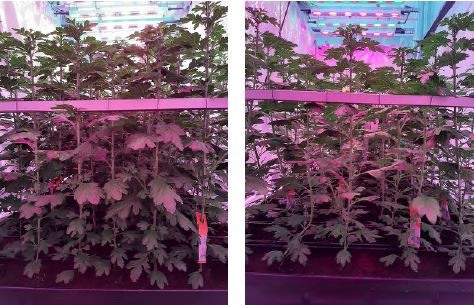Greenhouse horticulture is facing the challenge of reducing energy consumption in order to cut CO2 emissions. In lighted crops, the transition to LED lighting plays an important role in this regard. To make chrysanthemum cultivation profitable, the energy consumption for lighting and heating will have to be reduced. This has been shown to be possible in the subproject 'Growing Chrysanthemums with less electricity and less heat' by Kas als Energiebron et al.
In the study, Baltica and Pina colada chrysanthemums were grown at two temperatures: 'normal' and 'low' (18.5/18°C and 17.5/16.5°C; day/night), and at three light levels ('low,' 'medium' and 'high'; 6.0, 7.5 and 9.1 mol/m2/day). Plant densities and long day periods were adjusted according to the light levels. Lowering the cultivation temperature led to a delay in flower branch development.

Growth duration was not affected by the light levels, but lower light intensity led to lower branch weight. The fresh production expressed as kg per m2 decreased significantly with lower light intensity, proportionally to the decrease in plant density. There appeared to be no impact on the extent of thrips or Botrytis damages.
Matching heat, light, and cultivation decisions
The main question was whether it is possible to coordinate temperatures, light levels, and cultivation decisions, such as the number of short days or the plant density, in such a way that stable plant quality can be obtained. The results point to the answer to this question, "Yes, it is possible."
The test has been carried out with two varieties: Baltica and Pina colada. Despite the fact that, in the beginning, it seemed that the varieties differed in their sensitivity to lower cultivation temperatures, at the end of the cultivation period, it was found that the results of both varieties were similar.
The results of this test indicate that it is quite possible to grow chrysanthemums with less energy without adverse effects on branch weight or branch length. The cultivation strategy does need to be adjusted to the lower temperatures and light levels to maintain branch quality. This means lower production per m2. Depending on the conditions, growers will need to design their own strategies.
The report can be consulted here.
Source: Kas als Energiebron
